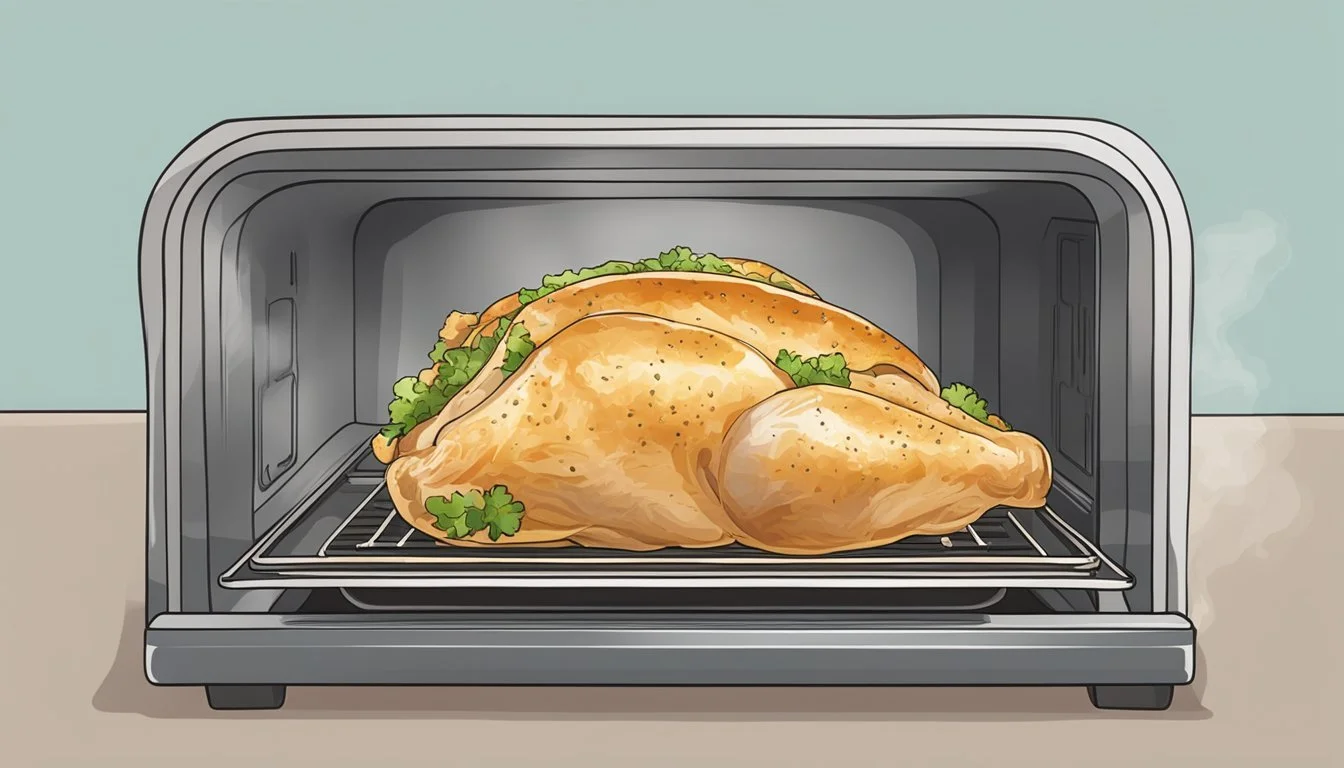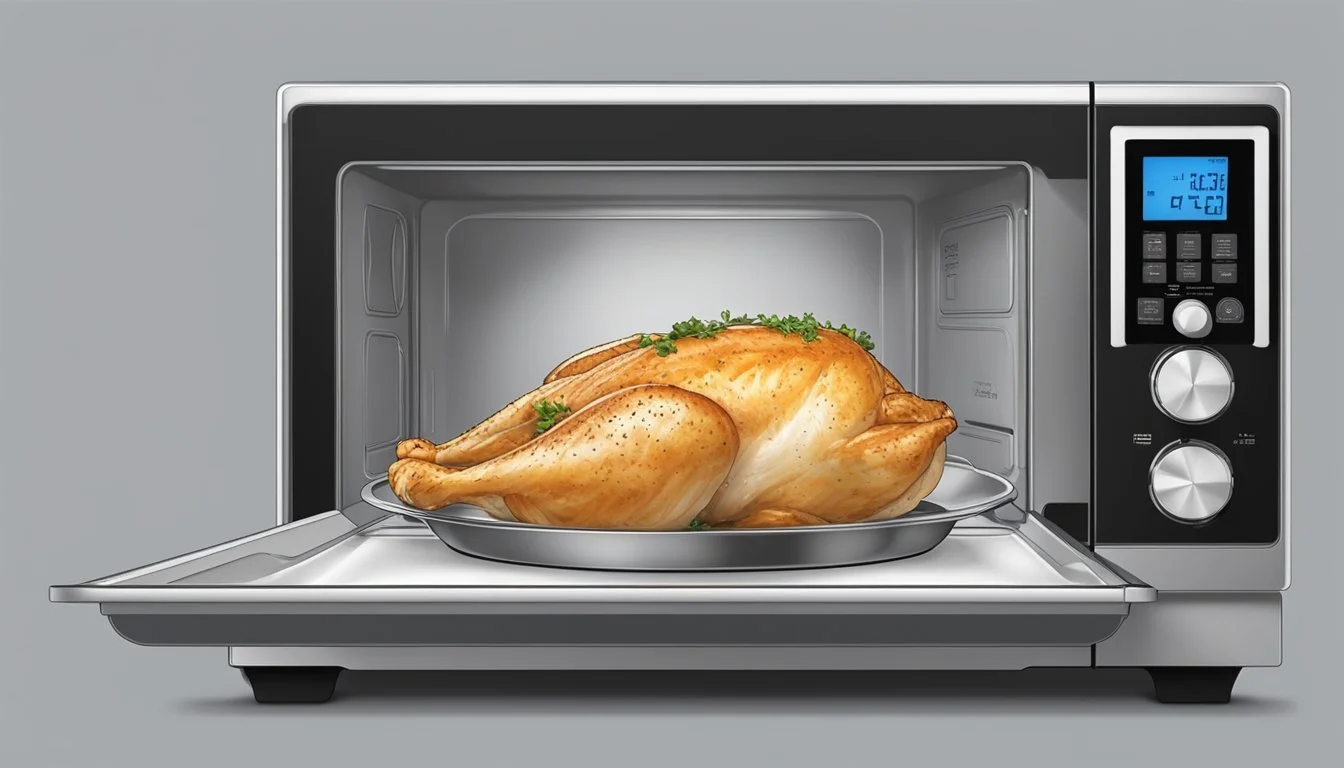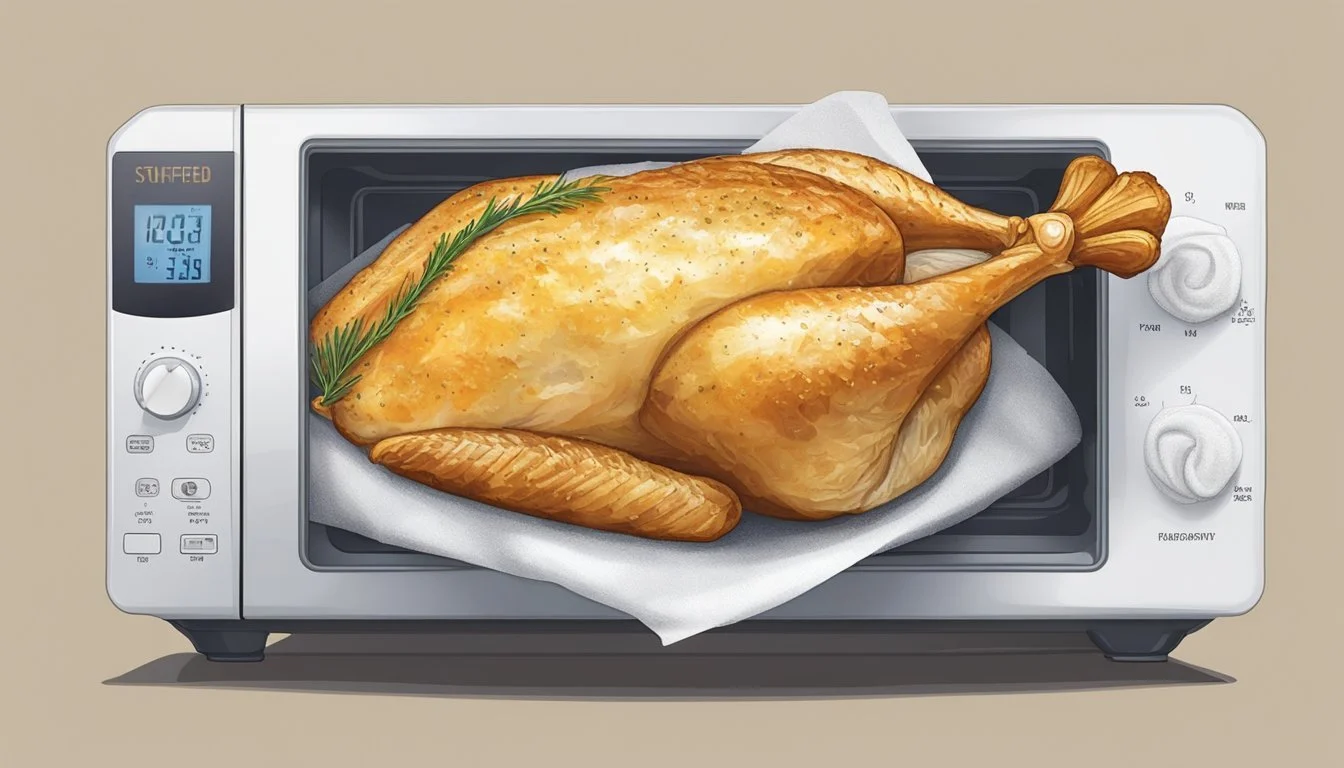Best Way to Reheat Stuffed Chicken Breast
Ensuring Moistness and Flavor Retention
Reheating stuffed chicken breast while maintaining its moistness and flavorful filling can be a culinary challenge. Stuffed chicken holds a delightful surprise within, and the goal is to restore it to its original state of juicy tenderness and taste. To achieve this, careful attention must be paid to the method used for reheating to ensure that the meat does not become dry and the fillings remain succulent.
A common misconception is that reheating chicken always leads to a poor outcome. However, by understanding the properties of chicken and by employing the right techniques, one can reheat stuffed chicken breasts effectively. The importance lies in the approach taken—whether using a microwave with attention to power settings and moisture retention, an oven that circulates heat evenly while preventing drying out, or a stovetop method that offers quick and precise heat. Each method has its own set of steps to best preserve the succulence of both the chicken and its filling, ensuring a thoroughly warmed dish that retains its intended flavors and textures.
Essentials of Reheating Chicken
Reheating chicken, particularly when it’s stuffed, requires a delicate balance to maintain its moisture and flavor. Understanding the available methods and best practices is crucial for enjoying leftover chicken that's as close to its original state as possible.
Understanding Reheating Methods
Microwave:
Time: 2-4 minutes per piece on medium power.
Method: Place on a microwave-safe plate, cover with a damp paper towel or microwave-safe cover.
Tip: Check for an even internal temperature using a food thermometer.
Oven:
Temperature: Preheat to 350°F (175°C).
Method: Wrap chicken in foil, place in an oven-safe dish.
Duration: 15-20 minutes or until an internal temperature of 165°F (74°C) is reached.
Preserving Moisture and Flavor
Adding Liquids: Adding a small amount of liquid such as water or chicken broth to the dish when reheating in the oven or on the stove can help preserve the chicken's moisture.
Oven: Just enough to cover the bottom of the baking dish.
Stovetop: Just enough to cover the bottom of the skillet, heat, then add the chicken and cover.
Temperature Check: Ensuring chicken reaches an internal temperature of 165°F (74°C) is critical for both safety and preserving moisture. Overheating can dry out and toughen the meat. Use a food thermometer to check the temperature without frequently cutting into the meat, which can release vital juices.
Preparation for Reheating
Before delving into the reheating process for stuffed chicken breast, proper storage is vital for preserving moisture and flavor. Equally important is the correct method of preparing it for reheating to ensure optimal taste and safety.
Storing Leftover Chicken
When storing leftover stuffed chicken breast, one should ensure that the chicken is cool enough to handle but not left out at room temperature for more than two hours to prevent bacterial growth. It should then be wrapped securely in plastic wrap or aluminum foil before placing it in the fridge. The aim is to create an airtight barrier that retains moisture and keeps odors from the fridge from being absorbed into the chicken.
Temperature: Keep the fridge temperature below 40°F (4°C) to slow down bacterial growth.
Space: Avoid overcrowding; ample space allows for consistent cooling.
Preparing Chicken for Reheating
Prior to reheating, one should bring the leftover chicken breast to room temperature for about 15 to 30 minutes—this step promotes even heating. When using an oven or microwave, the chicken breast should be loosely covered, ideally using foil in the oven and a microwave-safe cover or a damp paper towel in the microwave, to prevent the surface from drying out.
Oven: Preheat to 350°F (177°C). The chicken should be placed in an oven-safe dish with a tablespoon or two of water or broth to keep it moist.
Microwave: Use medium power setting. Duration varies by the microwave, typically 2-4 minutes.
Reheating in the Oven
Reheating stuffed chicken breast in the oven is a reliable method to ensure even heating while maintaining the moisture and flavors of the filling. For optimal results, it's important to monitor the internal temperature with a food thermometer.
Oven Reheating Technique
To reheat your stuffed chicken breast in the oven, one should:
Preheat: Turn the oven on and set it to 350°F. This moderate temperature helps warm the chicken without burning the exterior or overcooking the delicate filling.
Room Temperature: Remove the chicken from the refrigerator and let it sit until it reaches room temperature. This ensures more even reheating and protects the breast from drying out.
Prepare an Oven-Safe Dish: Choose an oven-safe dish just large enough to hold the chicken snugly. This prevents excessive airflow from drying out the meat.
Internal Temperature: Use a food thermometer to ensure the stuffed chicken breast reaches a safe and palatable internal temperature of 165°F before consumption.
Using Foil and Oven-Safe Dishes
Foil Usage:
Cover the Chicken: Gently wrap the stuffed chicken breast with aluminum foil. The foil acts as a moisture barrier, trapping steam and preventing the chicken from drying out during the reheating process.
Oven-Safe Dish:
Selection and Preparation: An oven-safe dish provides a controlled space for reheating. To prevent sticking, one might lightly grease the dish or add a thin layer of liquid like broth or water.
Placement and Heat Distribution: Position the chicken in the center of the dish. The uniform heat of the oven circulates around the foil-wrapped chicken, promoting consistent reheating of the filling and exterior.
Reheating on the Stove
Reheating stuffed chicken breast on the stove allows for precise temperature control, ensuring the chicken remains moist while the filling stays flavorful.
Skillet Reheating Method
For the skillet reheating method, one requires a skillet or frying pan that evenly distributes heat. A heavy-bottomed pan is preferable to prevent burning. The cook should begin by adding a thin layer of oil or chicken broth to the skillet to create a moist environment; olive oil is often recommended for its flavor and high smoke point. A medium heat setting allows the chicken to gradually warm without overcooking.
Step 1: Add a small amount of olive oil or chicken broth to the pan.
Step 2: Place the stuffed chicken breast in the skillet once heated.
Step 3: Cover with a lid to trap steam and ensure even reheating.
Step 4: Reheat the chicken to a safe internal temperature of 165°F, checking with a thermometer.
Managing Heat and Liquids
Managing the heat and liquids in the pan is crucial for keeping the stuffed chicken breast moist and preserving its crispy exterior. One should adjust the stove to a low to medium setting to avoid overheating, which can lead to a dry and tough texture.
Consistency: Check the skillet regularly, flipping the chicken as needed for even heating.
Moisture: If the pan dries out, add more broth sparingly to replenish moisture without making the filling soggy.
Crispiness: To maintain a crispy exterior, one can briefly increase the heat towards the end of reheating, but it's important to attend closely to prevent burning.
Reheating in the Microwave
Reheating stuffed chicken breast in the microwave can be quick and convenient, but it requires careful attention to technique in order to maintain the dish's moisture and flavor.
Microwave-Safe Techniques
When reheating stuffed chicken breast in a microwave, it's important to use a microwave-safe plate. The user should arrange the chicken pieces evenly on the plate, ensuring they're not overlapping to allow for even reheating. Here's a straightforward guide:
Place the chicken on the microwave-safe plate.
Cover the chicken with a damp paper towel to create a moist environment during reheating.
Reheat the stuffed chicken breast on medium power, heating in 2-minute increments and checking for even warmth throughout.
Preventing Dryness and Rubberiness
The texture of the chicken is paramount. To avoid the stuffed chicken breast from becoming dry or rubbery, one should:
Moisture: Introduce a slight amount of moisture by means of a damp paper towel over the chicken during reheating.
Time: Carefully time the reheating process, checking every minute to prevent overheating.
Power: Use a lower power setting in the microwave to gently warm the chicken without cooking it further.
By working in increments and maintaining a moist environment in the microwave, the chicken should retain its juicy filling and delicate texture.
Alternative Reheating Methods
When seeking to retain the moistness and flavor of stuffed chicken breast while achieving a satisfying texture, one can opt for alternative reheating methods such as using an air fryer or broiling.
Using the Air Fryer
An air fryer offers a fast and effective way to reheat stuffed chicken breast. To ensure even cooking, place the chicken in the air fryer basket without overcrowding. Set the air fryer to 350°F and heat for about 5-7 minutes. Check the internal temperature to ensure it has reached 165°F, indicating that it is thoroughly warmed. This method helps maintain moisture while adding a slight crispness to the exterior.
Broil for a Crisp Finish
The broiling function of an oven can be used to reheat chicken, giving the surface a crunchy texture. Initially, preheat the broiler. Place the chicken on a broiler-safe tray and set it in the oven, ensuring it is not too close to the heat element to avoid burning. Broil for 2-3 minutes on each side, monitoring closely. The direct, intense heat creates a delightful crisp while the short cooking time helps prevent drying out the filling.
Safety and Internal Temperature
Ensuring the safety of reheated stuffed chicken breast revolves around achieving the correct internal temperature. This practice eliminates harmful bacteria and preserves the quality of the meal.
Checking for Proper Reheat Temperature
When reheating stuffed chicken breast, one must aim for an internal temperature of 165°F (74°C). To accurately measure this, the use of a food or meat thermometer is essential. Insert the thermometer into the thickest part of the chicken breast, avoiding the filling, to get an accurate reading.
To summarize, the key steps are:
Use a food thermometer to check the temperature.
Insert the probe into the thickest part of the meat.
Ensure the temperature reads at least 165°F (74°C) for food safety.
Following these guidelines helps maintain a balance between safety and preserving the delicious qualities of stuffed chicken breast.
Enhancing Reheated Chicken
When reheating stuffed chicken breast, maintaining moisture and flavor is paramount. The use of broths, sauces, and seasonings can enhance the chicken, making it just as enjoyable as when it was first cooked.
Adding Moisture with Broths and Sauces
When reheating chicken, dryness is a common issue. One can counteract this by incorporating broth or sauce. A small amount of chicken broth can be added to the dish before covering it with foil. This creates a moist environment, reminiscent of the chicken's initial cooking conditions. Similarly, a sauce or gravy can also be added, which not only adds moisture but also infuses the chicken with additional flavors. When opting for a sauce or gravy, it is beneficial to ensure it complements the filling of the stuffed chicken breast to amplify the overall taste.
Method:
Add 1-2 tablespoons of chicken broth or appropriate sauce to the chicken.
Cover with aluminum foil to seal in the moisture.
Seasoning for Reinvigorated Flavor
Seasoning not only adds flavor but also can help restore the taste profile of the chicken to its original state. A light sprinkling of salt and pepper can make a significant difference, enhancing the chicken's natural flavors. For a more flavorful experience, one might consider using the same spices that were used in the initial preparation. This reinforces the chicken's seasoning without overwhelming the existing flavors of the stuffing.
Recommendation:
Sprinkle lightly with salt and pepper before reheating.
Use complementary spices to match the chicken's original seasoning profile.
Special Considerations
When reheating stuffed chicken breast, particular attention must be paid to the preparation type, quantity, and storage methods to maintain quality. Specific techniques ensure that breaded or bone-in varieties remain flavorful, and large amounts are warmed evenly without sacrificing texture.
Reheating Breaded or Bone-in Chicken
Breaded chicken requires careful handling to preserve its crisp exterior. One should reheat it in an oven set to 350°F (175°C), preferably on a wire rack over a baking sheet to allow even air circulation. For bone-in chicken, it's advisable to remove meat from the bone before reheating to achieve even warmth throughout.
Managing Large Amounts
Reheating a large amount of leftover chicken breast can be challenging. To ensure uniform heating, it's best to:
Arrange the chicken in a single layer on the baking dish.
Add a small amount of broth or water to the dish to maintain moisture.
Cover the dish with foil to trap steam and heat evenly.
Freezing and Reheating Chicken
Freezing stuffed chicken breast for future meals is convenient. For best results:
Cool the chicken thoroughly before freezing.
Wrap it tightly to prevent freezer burn.
Use an oven for reheating to ensure the center gets hot without drying out the edges. Always ensure the internal temperature reaches 165°F (74°C) when reheated for safe consumption.
Final Thoughts
When it comes to reheating chicken breast, especially when it's stuffed, retaining the original flavor and moisture is paramount. They should pay close attention to the reheating method they choose, as it can greatly affect the quality of the leftovers.
Microwave: It's a quick option, where they should place the chicken on a microwave-safe plate, cover it with a damp paper towel, and reheat on medium power for 2-4 minutes. They must check the internal temperature, ensuring it reaches 165°F.
Oven: Preheating the oven to 350°F and reheating the chicken breast covered with foil for 15-20 minutes can preserve its juiciness.
Stovetop: A skillet with a small amount of water, reheating over medium heat until the chicken reaches 165°F, serves as an alternate method.
One should note that the key to a successful reheat is moisture retention. To this end, they might add a bit of water or broth in the selected reheating container, whether it is the baking dish for the oven or the skillet for the stove.
It's also crucial to allow the chicken to reach room temperature before reheating to ensure even warming. For those eating leftovers, the goal is to closely mimic the freshness and flavors of the initial meal. By following the right techniques, they can enjoy their reheated stuffed chicken breast without compromise.








